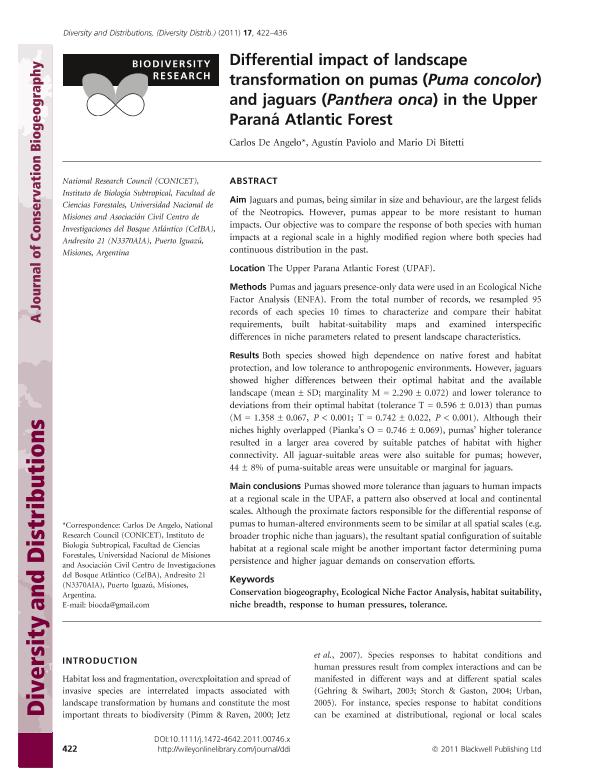Mostrar el registro sencillo del ítem
dc.contributor.author
de Angelo, Carlos Daniel

dc.contributor.author
Paviolo, Agustin Javier

dc.contributor.author
Di Bitetti, Mario Santiago

dc.date.available
2018-04-23T21:27:50Z
dc.date.issued
2011-05
dc.identifier.citation
de Angelo, Carlos Daniel; Paviolo, Agustin Javier; Di Bitetti, Mario Santiago; Differential impact of landscape transformation on pumas (Puma concolor) and jaguars (Panthera onca) in the Upper Paraná Atlantic Forest; Wiley Blackwell Publishing, Inc; Diversity and Distributions; 17; 3; 5-2011; 422-436
dc.identifier.issn
1366-9516
dc.identifier.uri
http://hdl.handle.net/11336/43170
dc.description.abstract
Aim Jaguars and pumas, being similar in size and behaviour, are the largest felids of the Neotropics. However, pumas appear to be more resistant to human impacts. Our objective was to compare the response of both species with human impacts at a regional scale in a highly modified region where both species had continuous distribution in the past.
Location The Upper Parana Atlantic Forest (UPAF).
Methods Pumas and jaguars presence‐only data were used in an Ecological Niche Factor Analysis (ENFA). From the total number of records, we resampled 95 records of each species 10 times to characterize and compare their habitat requirements, built habitat‐suitability maps and examined interspecific differences in niche parameters related to present landscape characteristics.
Results Both species showed high dependence on native forest and habitat protection, and low tolerance to anthropogenic environments. However, jaguars showed higher differences between their optimal habitat and the available landscape (mean ± SD; marginality M = 2.290 ± 0.072) and lower tolerance to deviations from their optimal habitat (tolerance T = 0.596 ± 0.013) than pumas (M = 1.358 ± 0.067, P < 0.001; T = 0.742 ± 0.022, P < 0.001). Although their niches highly overlapped (Pianka’s O = 0.746 ± 0.069), pumas’ higher tolerance resulted in a larger area covered by suitable patches of habitat with higher connectivity. All jaguar‐suitable areas were also suitable for pumas; however, 44 ± 8% of puma‐suitable areas were unsuitable or marginal for jaguars.
Main conclusions Pumas showed more tolerance than jaguars to human impacts at a regional scale in the UPAF, a pattern also observed at local and continental scales. Although the proximate factors responsible for the differential response of pumas to human‐altered environments seem to be similar at all spatial scales (e.g. broader trophic niche than jaguars), the resultant spatial configuration of suitable habitat at a regional scale might be another important factor determining puma persistence and higher jaguar demands on conservation efforts.
dc.format
application/pdf
dc.language.iso
eng
dc.publisher
Wiley Blackwell Publishing, Inc

dc.rights
info:eu-repo/semantics/openAccess
dc.rights.uri
https://creativecommons.org/licenses/by-nc-sa/2.5/ar/
dc.subject
Conservation Biogeography
dc.subject
Response to Human Pressures
dc.subject
Habitat Suitability
dc.subject
Tolerance
dc.subject
Niche Breadth
dc.subject
Ecological Niche Factor Analysis
dc.subject.classification
Otras Ciencias Biológicas

dc.subject.classification
Ciencias Biológicas

dc.subject.classification
CIENCIAS NATURALES Y EXACTAS

dc.title
Differential impact of landscape transformation on pumas (Puma concolor) and jaguars (Panthera onca) in the Upper Paraná Atlantic Forest
dc.type
info:eu-repo/semantics/article
dc.type
info:ar-repo/semantics/artículo
dc.type
info:eu-repo/semantics/publishedVersion
dc.date.updated
2018-04-18T15:17:54Z
dc.identifier.eissn
1472-4642
dc.journal.volume
17
dc.journal.number
3
dc.journal.pagination
422-436
dc.journal.pais
Reino Unido

dc.journal.ciudad
Londres
dc.description.fil
Fil: de Angelo, Carlos Daniel. Consejo Nacional de Investigaciones Científicas y Técnicas. Centro Científico Tecnológico Conicet - Nordeste. Instituto de Biología Subtropical. Instituto de Biología Subtropical - Nodo Posadas | Universidad Nacional de Misiones. Instituto de Biología Subtropical. Instituto de Biología Subtropical - Nodo Posadas; Argentina
dc.description.fil
Fil: Paviolo, Agustin Javier. Consejo Nacional de Investigaciones Científicas y Técnicas. Centro Científico Tecnológico Conicet - Nordeste. Instituto de Biología Subtropical. Instituto de Biología Subtropical - Nodo Posadas | Universidad Nacional de Misiones. Instituto de Biología Subtropical. Instituto de Biología Subtropical - Nodo Posadas; Argentina
dc.description.fil
Fil: Di Bitetti, Mario Santiago. Consejo Nacional de Investigaciones Científicas y Técnicas. Centro Científico Tecnológico Conicet - Nordeste. Instituto de Biología Subtropical. Instituto de Biología Subtropical - Nodo Posadas | Universidad Nacional de Misiones. Instituto de Biología Subtropical. Instituto de Biología Subtropical - Nodo Posadas; Argentina
dc.journal.title
Diversity and Distributions

dc.relation.alternativeid
info:eu-repo/semantics/altIdentifier/doi/http://dx.doi.org/10.1111/j.1472-4642.2011.00746.x
dc.relation.alternativeid
info:eu-repo/semantics/altIdentifier/url/https://onlinelibrary.wiley.com/doi/abs/10.1111/j.1472-4642.2011.00746.x
Archivos asociados
